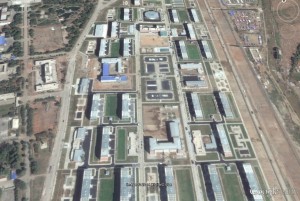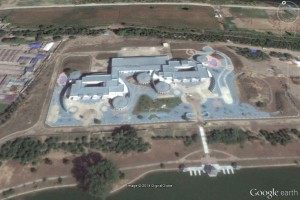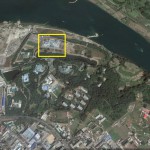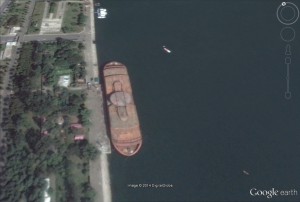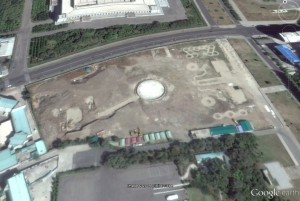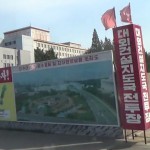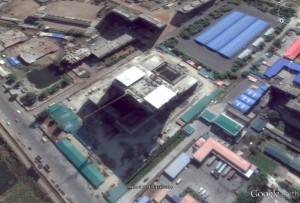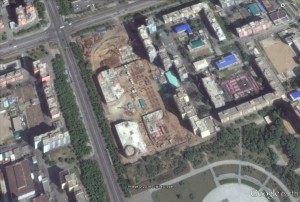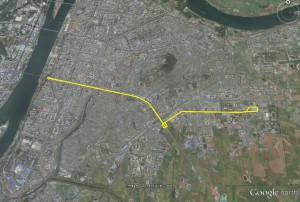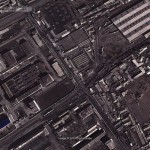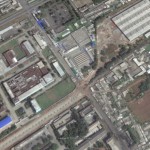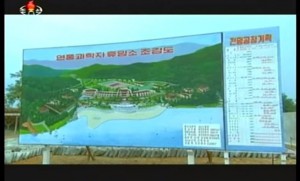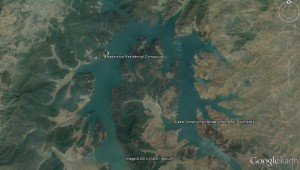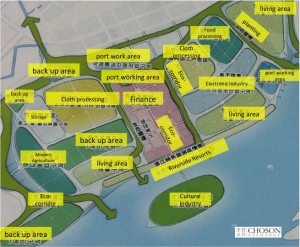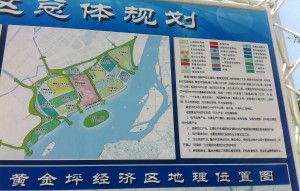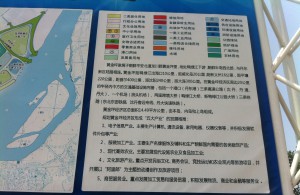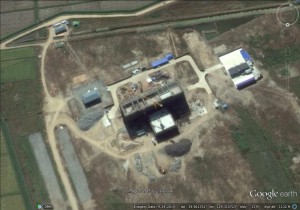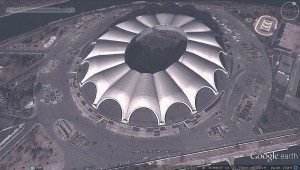UPDATE 10 (2014-10-30): Satellite imagery on Google Earth confirms that the new building was nearly completed by September 21. So the basic frame of the new building was completed in just a few months! How safe do you think it is!
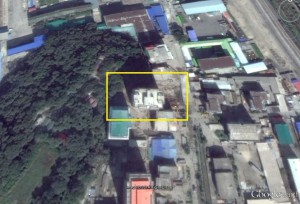
UPDATE 9 (2014-10-20): Satellite imagery confirms the North Koreans are rebuilding on the site of last summer’s building collapse:
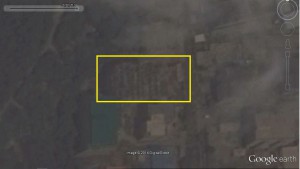
This image was taken on 2014-7-3, so it could be completed by now.
More at Radio Free Asia (in Korean)
UPDATE 8 (2014-7-7): NK News reports that the DPRK requested assistance in relationship to the collapsed building.
“The Korea Rescue Association got a request from the ‘General Bureau of Red Star Construction’ for assistance related to the Pyongyang apartment collapse, [and] on July 6th they submitted a request to visit North Korea,” a Daily NK translation of the statement said.
The statement added that the Korea Rescue Association requested entry into North Korea on June 26 to further investigate the situation, but were still awaiting a decision.
Unusually, the request for South Korean assistance appears to have come nearly four weeks after the May 13 accident occurred, on June 9.
UPDATE 7 (2014-7-3): NK News provides independent corroboration to North Korean claims that a Pyongyang apartment block collapsed on May 13, confirming the subsequent search, rescue and clean-up operation was completed in under just four days.
UPDATE 6 (2014-6-12): The Daily NK reports that rumors are circulating in Pyongyang that the building collapse was the fault of Jang Song-thaek.
UPDATE 5 (2014-6-3): NK News has an exclusive report done with All Source Analysis on the building collapse. Includes great information and the first satellite images of the site after the collapse.
UPDATE 4 (2014-5-24): The Daily NK offers information purported to come from Pyongyang.
UPDATE 3 (2014-5-22): Everyone seems to agree that the decision to go public was made only after there was “nothing more to see here”. The motivation for going public with this story is unknown–even today accidents resulting in loss of life are rarely reported in the DPRK media. There are two (at least) theories. One theory is that foreign reporters were tipped off and began calling North Korean embassies asking questions. A second theory is that North Koreans were spreading news of the collapse via cell phone so the government needed to take public action. These theories are not mutually exclusive. We still do not know when exactly the building collapsed or how many were injured or killed. None of the injured victims have appeared in the DPRK media.
The speed with which the rubble was removed from the site is also remarkable. Where was it taken? Maybe one day a satellite image will appear that reveals the answer. However, judging from the official photos, it appears to me that some rubble was not removed, it was simply covered over with dirt.
UPDATE 2 (2014-5-21): Kim Jong-un followed up the building collapse with a visit to the Taesongsan General Hospital where he met with injured soldiers (construction workers?) and orphans. If there were any survivors from the collapsed building at the hospital, the media reports did not mention them. Next he visited new apartment housing for instructors at Kim Chaek University of Technology. Let’s hope these apartment buildings don’t collapse.
UPDATE 1 (2014-5-19): This was picked up by the following media: The Diplomat, 노컷뉴스, Radio Free Asia, 국제신문, Reuters. The Choson Ilbo used the information from this report but did not cite the source.
ORIGINAL POST (2014-5-18):
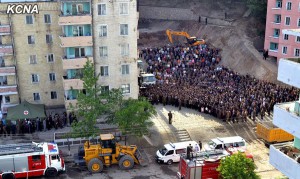
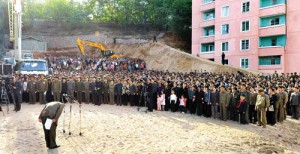
KCNA has announced the tragic collapse of a high-rise apartment building in Phyongchon District:
Pyongyang, May 18, 2014 00:00 KST (KCNA) — It is the consistent stand of the Workers’ Party of Korea and the state to prioritize the interests and conveniences of the people and hold them absolute and protect their lives and properties.
But there occurred a serious accident in the construction site in Phyongchon District, Pyongyang on May 13 as the construction of an apartment house was not done properly and officials supervised and controlled it in an irresponsible manner. The accident claimed casualties.
Right after the accident the state emergency mechanism was put into action to conduct an intensive campaign to rescue survivors, treat the wounded and arrange the scene of the accident.
The rescue operation came to an end on May 17.
Minister of People’s Security Choe Pu Il, General Officer of the Korean People’s Internal Security Forces Sonu Hyong Chol, Chairman of the Pyongyang City People’s Committee Cha Hui Rim, Chief Secretary of Phyongchon District Committee of the WPK Ri Yong Sik and other officials concerned met the bereaved families, citizens in the district and other Pyongyangites to express deep consolation and apology.
Choe Pu Il said the responsibility for the accident rests with him as he failed to uphold well the WPK’s policy of love for the people. He repented of himself, saying that he failed to find out factors that can put at risk the lives and properties of the people and to take thorough-going measures, thereby causing an unimaginable accident.
With nothing can he atone for the crime he committed against the people and he can never be pardoned, he said, repeatedly expressing deep apology to the bereaved families and other Pyongyang citizens.
He made a firm pledge to make sure that the Ministry of People’s Security becomes a genuine security organ which always protects the interests, lives and properties of the people, true to the party’s noble intention of putting the popular masses above all.
Sonu Hyong Chol said that he was chiefly to blame for the accident as he was in charge of the construction. He expressed heart-felt consolation and sympathy to the victims and the bereaved families and said he was making an apology, his head bent, to other Pyongyang citizens who were greatly shocked by the recent accident.
The party has always stressed the importance of raising the quality of structure, but he did the construction in a slipshod manner as he did not have the proper stand of serving the people, thus causing such a serious accident, he said, making a solemn determination to do utmost to eradicate the aftermath of the accident and bring the living of the bereaved families to normal as early as possible.
Cha Hui Rim said that the party has always called on the officials to become genuine and faithful servants of the people but he failed to have the proper control over the construction of the apartment houses as a man responsible for the living of the citizens of the capital city, thereby causing such a serious accident. He has no face to stand before the bereaved families and other Pyongyang citizens and feels deep compunction for them, he said, pledging to make sure that the officials of the Pyongyang City People’s Committee do their utmost to alleviate even a little the pain of the victims and the bereaved families and bring their living to normal at the earliest possible date and to prevent the recurrence of similar accident.
Ri Yong Sik said that seeing for himself the victims in the scene of the accident, he felt as if his heart were falling apart and was too shocked to cry. He added that he could not raise his head for his guilty conscience as he failed to protect the precious lives of the people so much valued and loved by the party.
He made an apology to the bereaved families and to the citizens in the district again, vowing to come to senses, though belatedly, and motivate the officials in the district to bring the living of the bereaved families to normal, take good care of them, find out every possible cause of accidents and take preventive measures and thus fully guarantee the lives and security of the people.
Kim Su Gil, chief secretary of the Pyongyang City Committee of the WPK, said that the recent unexpected accident caused damage but there is loving care of our mother party which takes care of all people of the country and relieves their pain, adding that Marshal Kim Jong Un sat up all night, feeling painful after being told about the accident, instructed leading officials of the party, state and the army to rush to the scene, putting aside all other affairs, and command the rescue operation to recover from the damage as early as possible.
All Pyongyang citizens are sharing sorrow with the bereaved families and victims, he said, adding that the party and the state are taking effective emergency steps to bring the living of the families of victims to normal and provide them with new houses. He called on all to overcome sorrow with courage.
Based on information in KCNA, I can offer a satellite image of the collapsed building (pre-collapse):

The building was approximately 23 stories tall and approximately 15m x 23m per floor. Construction on the building began between May and September 2011 (image below)
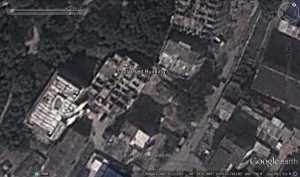
It is rather remarkable that the entire site could be cleared of debris in just four days. Additionally, I cannot see any serious damage to the surrounding buildings, though coverage is scarce. The neighborhood in which the collapsed building is located contains no less than 17 high-rises that are either under construction or recently completed. If I was living in one of these buildings I would not be feeling very confident right now.
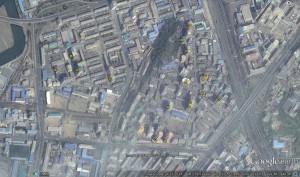
These buildings were part of the DPRK’s speed housing construction campaign to celebrate Kim Il-sung’s 100th birthday. Here is coverage in the New York Times. Here is coverage in Yonhap. Here is coverage in NK News. Here is coverage in the Wall Street Journal. Here is coverage by Choson Exchange. Here is coverage in the Washington Post. Here is coverage in the Daily NK.

